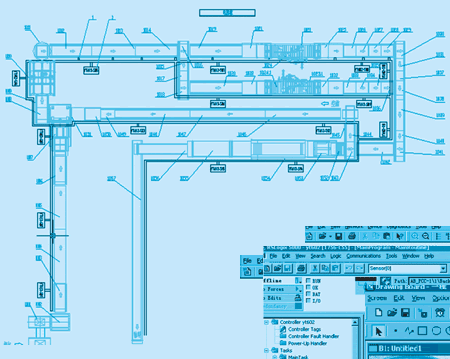摘要:大部分的数控(CNC)系统对用户是封闭的。通常情况下,工程师们除了在机器上编程外,做不了更多的事情。即使有一个所谓的程序编程接口(包括三维可视化和过程模拟,预先定义的铣/车削周期,甚至一个小的CAD / CAM系统) ,系统仍然不能由用户随意修改。
尽管现在只有开发者了解技术细节,但开放式体系控制系统已经成为现代控制系统最为明显的发展趋势。用来形容今天的控制系统,“开放”这一词是相当时髦的说法。
英文全文如下:
CNC open architectures
Krzysztof Pietrusewicz, Ph.D., Control Engineering Poland
Most computer numerical control (CNC) systems are closed for users. Engineers typically can only program the machine, nothing more. Even if it has a so-called programming interface (including 3D vis
Open architecture control systems, however developers understand them, are a noticeable trend of modern control systems technology. “Open” is a very fashionable way to describe today’s control systems.
Many efforts are underway to make control system architectures more open. It helps to define the degree of openness of the proposed control system.
Evaluate CNC openness
A variety of open-architecture control systems can be found on the Internet. These include OSACA (Open System Architecture for Controls within Automation Systems), OMAC (Open Modular Architecture Controllers), NGC (Next Generation Controller project, National Center for Manufacturing Sciences), and OSEC (Open System Environment for Controller) control architectures, as well as others.
But what defines CNC openness? Can the degree of control system openness be measured?
A means for rating the openness of major control system attributes is provided in Chi Yonglin’s paper, “An evaluation space for open architecture controllers” (International Journal of Advanced Manufacturing Technology, 2005).
Rating categories include applicable control system domain (0 rating means that the controller has been designed as special equipment; a 10 rating means it can be used for all domains of the manufacturing industry), as well as extensibility and scalability (0: traditional closed architecture, 10: a full open architecture whose topology can change depending on the application.)
Similar measurements can be made for other aspects of openness, such as modularized structure, standardized interface, function and performance requirements and more.
Once the relative “openness” of a system is ascertained, however, the truest measure comes when putting the technology into action within a production environment.
Project OCEAN
Project OCEAN (Open modular Control sys
Nearly seven years of research includes:
·Modeling of milling machine construction;
·Development of many control algorithms, including robust two degree of freedom, fuzzy-logic, neural networks, predictive and hybrid control;
·Laser 3D vibration monitoring; and
·Modeling of the feed drives of CNC machines.
Project OCEAN is among four ongoing mechatronics projects undertaken by an interdisciplinary team at University Centre of Mechatronics, Szczecin University of Technology. The team includes five professors, six doctors, four Ph.D. students, and OCEAN project director professor Stefan Domek, with the faculty of Electrical Engineering.

Intelligent CNC machines will diagnose themselves.
Self diagnostics for machine tools
OCEAN’s main goal is to introduce an open interface to develop diagnostic functions of the milling machine, test it, and introduce it to users. It includes:
·Motion control advanced algorithms;
·Different interpolation algorithms, including NURBS (Non Uniform Rational Basis or Bézier Spline), mathematical representations of 3D geometries;
·Flexible human-machine interface (HMI);
·Options to extend system kernel functions;
·Interface for the new flexible programming language; and
·Interface for the new active control system of the motion components.
Next, the project will develop:
·Full temperature model of the milling machine structure;
·Intelligent, self-diagnostics tools; and
·Noise and vibration control (active chatter suppression system of the tool-milling machine system is at the final stage of development).
University Centre of Mechatronics is seeking new partners for the next steps of the system; present cooperation is provided by Bernecker & Rainer, a Technology Provider and Integrator Member of OMAC. Project OCEA
Open CNC architectures
The use of open architecture CNC is gaining importance as a promising industrial automation technology. It allows integration of equipment, a friendly interface for configuration, and improved machine tool communication. Benefits of using an open architecture when developing new CNC includes lower-cost electronics and higher-performance computers.
Several types of open architectures are being developed in the USA, Europe, and Asia. All use a standard PC computer for control.
OSACA is used mostly in the software area. It first appeared in Europe with the Esprit III Project 6379 program, one of the largest projects involving standards for OAC (Open Architecture Control), including network connections and applications, defining an independent hardware with modular design, and allowing addition or removal of numeric control, robot control, PLCs, and other controllers.
OMAC is primarily for industrial applications. OMAC began in December 1994 with the publication of “Requirements of Open, Modular Architecture Controllers for Applications in the Automotive Industry” by Chrysler, Ford, and General Motors. This document served as a guide for North American automotive manufacturers’ use of controllers.
OSEC architecture is used for automation in many industrial areas to control manufacturing equipment, improve its pe rformance, and facilitate its maintenance.
HOAM-CNC (Hierarchical Open Architecture Multi-processor) system is for hardware (including new sensors and special modules).
Each architecture has integrated equipment from several manufacturers and the overall goal is to lower cost and not sacrifice performance.






